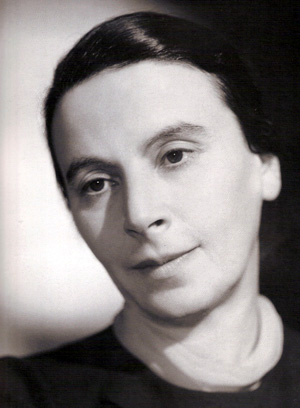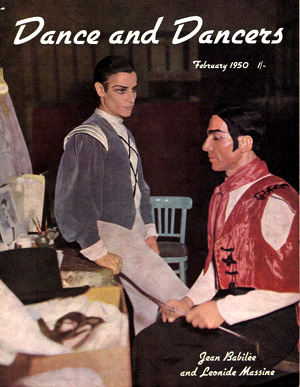| |
Testimonies
& Critics
Nijinsky' Galas at London, November 1949
At the time these notes are written, on November 2009, the 60th anniversary of this unique event on Dance' history is being reached. And certainly, it has not been ever repeated.
Vaslav Nijinsky, who was considered the greatest classical dancer on the XXth century, had lived the last thirty years of his life on a mental institute, and it's easy to imagine the precarious conditions of his existence for himself, as for his wife Romola and his daughter Kyra.
The Comtesse de Noailles wrote of Nijinsky: "All who have seen Nijinsky dance remain for ever impoverished by his absence, when they think of his precipitous flight to the low regions of melancholia, where now he lives. Nijinsky, whose body lived in space, without stay or support, Nijinsky, who as somebody fancifully said, "sometimes appeared to be painted on the ceiling". Those who have not seen him will never know the power of the youth, drunk with rythmical force, terrifying in his muscular energy, appearing to us as the grasshopper does to a child, when it proudly plays on the steel strings of its leg."
On account of Nijinsky's painful situation at that time, Madame Marie Rambert - whom Diaghilew had engaged to work with his Company on Stravinsky's complex rhythms of Le sacre du printemps - organised three Galas on his behalf, to be given at the Empress Hall in London, during November 1949.
 |
 |
Dame Marie Rambert
(photo:
Gordon Anthony, 1938) |
For this event, the most outstanding dancers in France were invited to perform: Tamara Toumanova, Yvette Chauviré, Marjorie Tallchief, Léonide Massine, Jean Babilée, George Skibine and Wladimir Skouratoff.
As it figures on the Notes to The Correspondence between Walter Gore and Marie Rambert, (Jane Pritchard,Dance Research, 1998), the Nijinsky Galas presented the following performances:
"L'après-midi d'un faune" with Jean Babilée and Margaret Hill;
"Les Sylphides" with Yvette Chauviré, Nathalie Krassovska, Paula Hinton and Wladimir Skouratoff;
"Giselle" (2nd.act) with Tamara Toumanova, Marjorie Tallchief and Wladimir Skouratoff;
"Capriccio Spagnol" (short version) with Léonide Massine, Tamara Toumanova, Marjorie Tallchief and George Skibine.
 |
 |
Massine on his costume for Capriccio Espagnol
and Babilée for Blue Bird (photo: Howard Byrne) |
(In the three first ballets the Ballet Rambert acted as the corps de ballet).
- "Don Quichotte" pas de deux with Toumanova and Skouratoff;
- "La mort du cygne" with Chauviré and Skouratoff;
- "Blue Bird" with Jean Babilée and Nathalie Krassovska.
We can easily imagine the success this Galas must have produced, on November 21, 22 and 23, 1949 at the London's Empress Hall. Nevertheless, as it figures also on the above mentionned article, "(...) they proved to be a financial fiasco. Apparently The Nijinsky Trust Fund only received 130 pounds, raised over the three performances."
At a note published in Dance and Dancers in February 1950, Vol.I nº 2, Tatlock Miller makes a review of this unique choregraphic event, from which we have extracted the following paragraphs:
"(…) we saw on this four-square platform several of the world's great dancers performing in honour to Nijinsky. These were three star-bright nights, with Russian, French and American prima ballerinas and premier danseurs, all of whom had flown to London for the occasion."
"Here, in glorious array and dancing in one programme for the first time, were Tamara Toumanova, Yvette Chauviré, Leonide Massine, George Skibine, Marjorie Tallchief, Wladimir Skouratoff, Jean Babilée and the Ballet Rambert, with its own guest artist Nathalie Krassovska. With Boris Kochno here to give artistic direction and with the spirit of the great Vaslav Fomich Nijinsky permeating everybody's thoughts with memories or legends, one had the feeling of being in the spot where history is being made (…) Those who had seen Nijinsky dance, and remembered his Pavillon d'Armide, his Jeux and Sacre du Printemps, spoke almost reverently of his extraordinary leap, his uncanny poising stilled in mid-air; while those unfortunates who had not seen with their own eyes felt a legend was being strengthened."
"Before the first of these performances, I watched for the whole day a tense rehearsal, one star shining after another. The air itself was electric, expectant with temperament that could have flown in six foreign directions."
"A harassed conductor was cajoled, pleaded with in a dozen languages to change his tempo, while an insisting microphone kept calling for Mr.Boris Kochno. And all the time, one felt that somewhere in this vast, partly fog-filled arena, Nijinsky sat watching, especially whilst Rambert and Massine rehearsed Babilée for his first performance of Faun. One moment found Madame Rambert herself prone upon the Faun's rocky hiding place, so absorbed, eager that the youthful Babilée should understand, know and reiterate Nijinsky's first choreographic essay, make it relive again, even though it could never re-create the sensational stir which it achieved on the night of February 17, 1913, when it was first performed in London."
"(…) Wladimir Skouratoff was a poet of great dignity. I watched one performance from behind the platform where ordinarily a back-cloth hangs and saw the seemingly effortless and beautiful ease with which Fokine's patterns unfold, come together and liquidate themselves."
Vaslav Nijinsky died in London on April 11th, 1950.
|
|